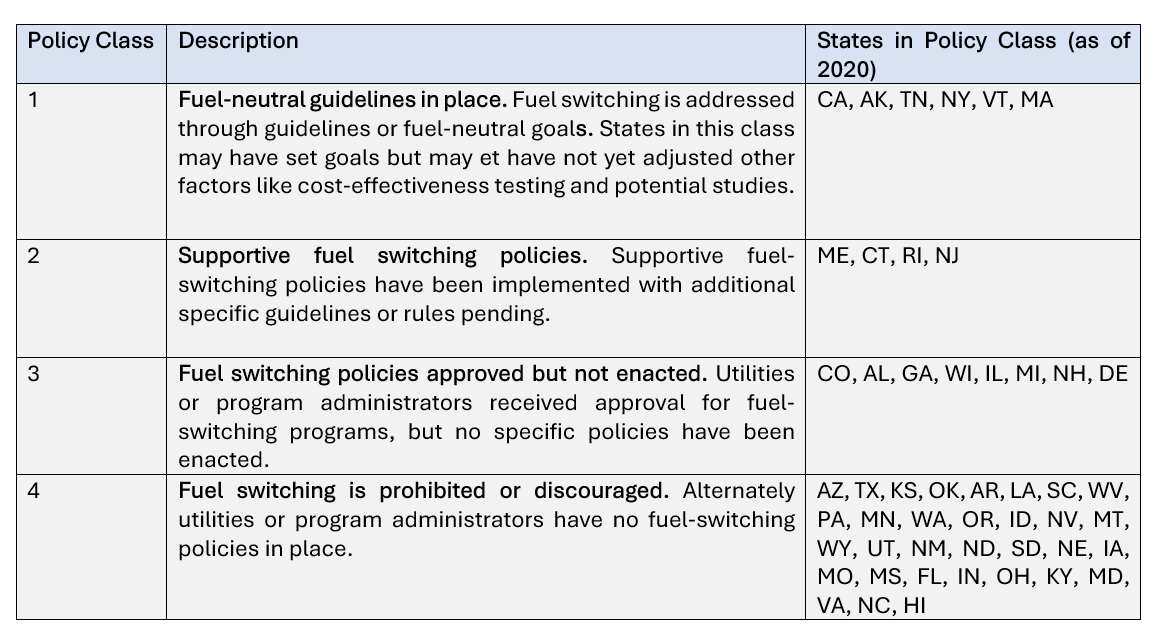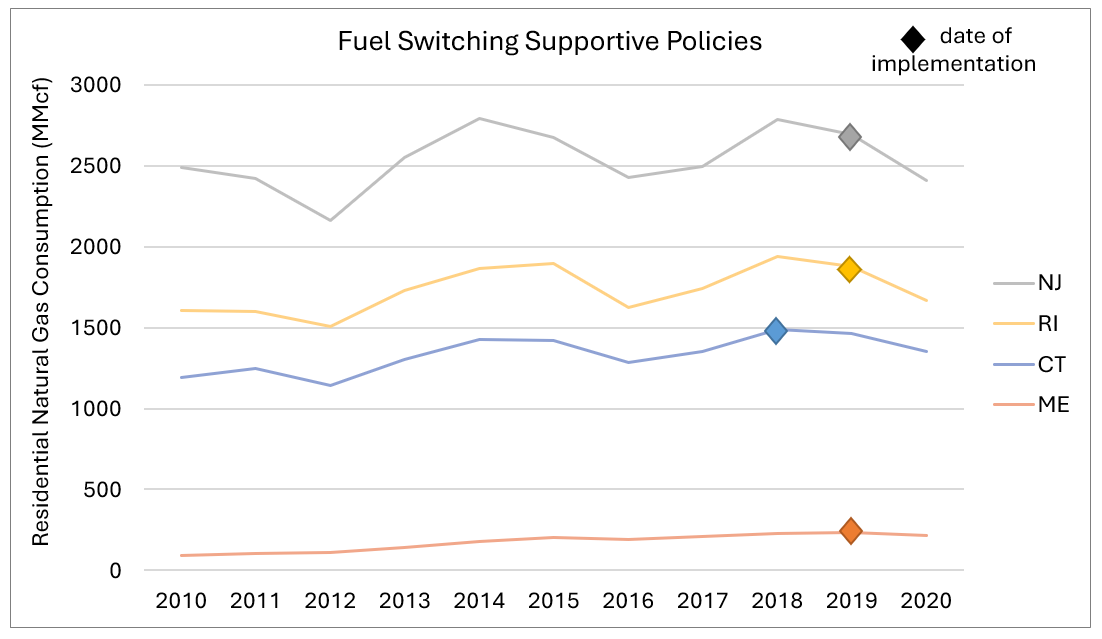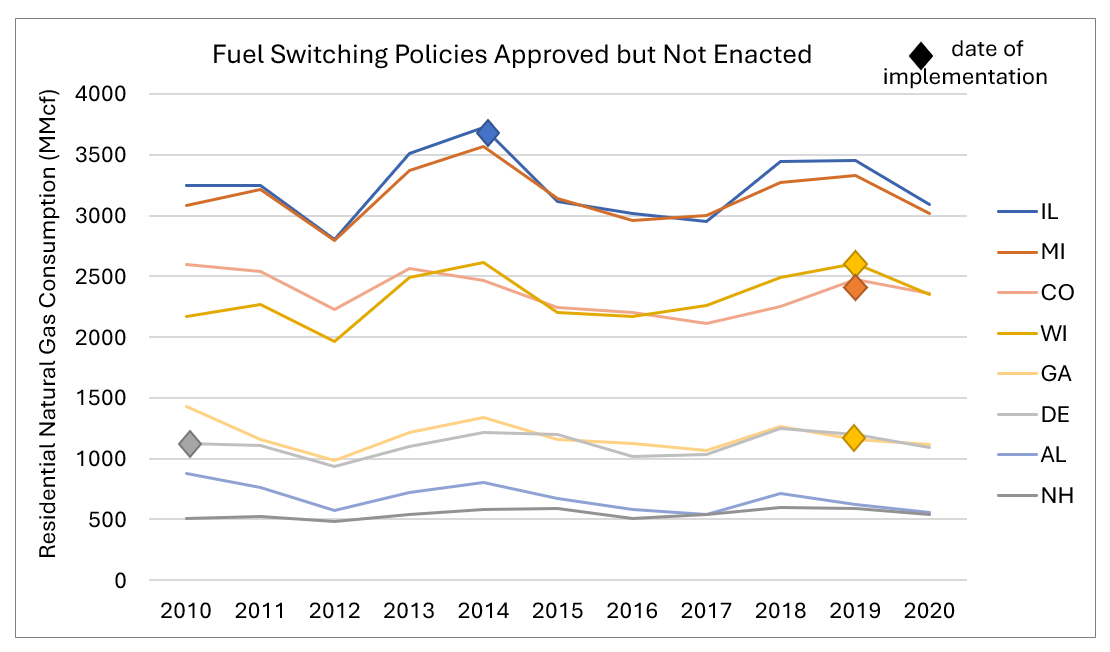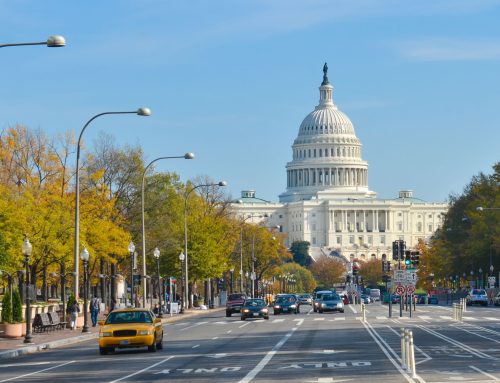
Introduction
Direct fossil fuel combustion in residential and commercial buildings accounts for approximately 13 percent of total greenhouse gas (GHG) emissions in the United States. Due to recent technological and market advancements, low-carbon building electrification technologies (e.g., cold-climate air source heat pumps, ground source heat pumps, or induction cooktops) can substantially reduce buildings-sector GHG emissions by eliminating or displacing fossil fuel combustion with clean electricity. To accelerate market deployment, states are exploring policy and program options that support building electrification. Most notably, some states have recently changed fuel switching rules in energy efficiency programs, enabling customers to use energy efficiency funds to switch from fossil fuels to building electrification technologies.
Fuel switching and substitution policy changes are notable because, historically, most states have prohibited, or at least discouraged, the use of energy efficiency incentives for fuel switching (i.e., switching from a non-regulated fuel like oil or propane to a regulated fuel like natural gas or electricity) or fuel substitution (i.e., switching from one regulated fuel to another). Regulators have discouraged fuel switching and fuel substitution because they do not wish to incentivize utility efficiency programs with a predominantly load building or load retention character. Moreover, energy efficiency programs were designed to save energy for a particular fuel type. Thus, regulators do not want to use, for example, natural gas ratepayer funds to cross-subsidize electricity customers. And in many cases, state energy efficiency programs were explicitly designed to save energy, not cut carbon emissions. Accordingly, there was no policy goal to encourage fuel switching.
However, in recent years, energy priorities have changed, and many states are placing a greater focus on carbon savings as opposed to energy savings. Changing fuel switching rules to allow utilities to electrify heating loads can enable states to achieve fuel-neutral energy savings, thereby contributing to carbon reduction in addition to energy savings priorities. This article examines what, if any, statistically significant effect fuel switching policies actually have on the market. This analysis shows that fuel switching and substitution policies do, in fact, have a statistically significant impact, reducing the use of natural gas as more building electrification technologies come online.
Analytical Approach
To assess the impacts of fuel switching and substitution policies in recent years, we used Buildings Hub data to analyze fossil fuel consumption in states with aggressive fuel-switching policies compared to those without fuel switching or fuel switching preemption policies. The analysis was structured to determine if fuel switching is in fact an effective tool for cutting down on residential fossil fuel use. Natural gas deliveries to customers served as the proxy measure for fossil fuel consumption in this assessment.
We categorized states into four different classes, leveraging research from the American Council for an Energy Efficient Economy (ACEEE) Policy Brief State Policies and Rules to Enable Beneficial Electrification in Buildings through Fuel Switching. Policy classes, descriptions, and state categorization are shown in Table 1 below. For the purposes of this analysis, we grouped the last two policy classes together into a single class four, which we used as our baseline to compare to natural gas usage from class one through class three states.
Table 1: Fuel Switching Policy Status by State

Table adapted from ACEEE Policy Brief: State Policies and Rules to Enable Beneficial Electrification in Buildings through Fuel Switching.
We gathered annual residential natural gas emissions data for all 50 U.S. states, which we normalized to the population of each state to account for fluctuations in the number of households using natural gas. We also gathered data on state policies that affected fuel switching of home heating, and the implementation date of these policies. Data were provided by Buildings Hub, the Energy Information Agency, and the Census Bureau. Fossil fuel consumption patterns by policy class are shown in Figure 1, with the policy enactment year indicated with a black star. We expect there to be a negative slope after the policy implementation date for states in policy classes one through three and a non-negative, or at least less negative slope, for class four.
Figure 1: Residential Natural Gas Consumption by Year and Policy Class



Results and Conclusions
Using linear predictive classification models, we were able to predict whether a state had implemented a class one or class two policy from the residential natural gas emissions data and year alone within a statistically significant degree of accuracy. Thus, we were able to conclude that when a state implements a class one (fuel-neutral guidelines in place) or class two policy (supportive fuel switching policies in place), this produces a statistically significant difference in residential natural gas consumption for that state. However, we were unable to predict with a high level of accuracy if a state had implemented a policy in class three (fuel switching rules approved but not enacted). Thus, we conclude that policies in class 3 do not produce a statistically significant difference in residential natural gas consumption compared to baseline states that have no policy or restrictive policies. For the states with policy classes 1 or 2, about 80 percent saw decreases in their residential natural gas consumption, with an average decrease of 5 percent in the first year after adoption and a decrease of 9 percent in the second year after adoption. This aligns with the notion that progressive fuel-switching policies correlate with adoption of low-carbon energy sources.
As the energy sector rapidly evolves to meet ambitious emissions reduction targets, every beneficial decarbonization tool must be utilized. Fuel switching, specifically from a combustible fuel source to a low-carbon source, has the potential to slash emissions in a meaningful way. For states prioritizing clean energy practices, fuel switching policies are already impacting fossil fuel consumption and will be an important guide in the future of decarbonization.



